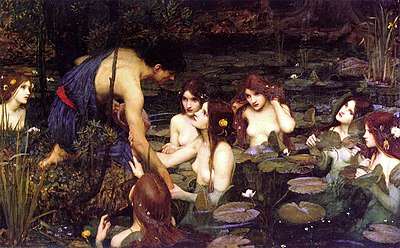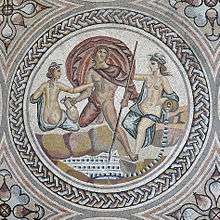Hylas
In classical mythology, Hylas (Ancient Greek: Ὕλας) was a youth who served as Heracles' (Roman Hercules) companion and servant, as well as lover. His abduction by water nymphs was a theme of ancient art, and has been an enduring subject for Western art in the classical tradition.

Genealogy
.jpg)
In Greek mythology, Hylas was the son of King Theiodamas of the Dryopians and the nymph Menodice (daughter of Orion).[1][2][3] In some accounts, his father was Euphemus[4] or King Ceyx of Trachis.[5]
Mythology
Heracles
After Heracles killed Theiodamas in battle, he took on Hylas as arms bearer and taught him to be a warrior, and in time the two fell in love. The poet Theocritus (about 300 BC) wrote about the love between Heracles and Hylas: "We are not the first mortals to see beauty in what is beautiful. No, even Amphitryon's bronze-hearted son, who defeated the savage Nemean lion, loved a boy—charming Hylas, whose hair hung down in curls. And like a father with a dear son he taught him all the things which had made him a mighty man, and famous."[6]
Argonauts
Heracles took Hylas with him on the Argo, making him one of the Argonauts. Hylas was kidnapped by nymphs of the spring of Pegae, Mysia when they fell in love with him, and he vanished without a trace (Apollonios Rhodios). This greatly upset Heracles, who was his lover[7] (erastes), so he along with Polyphemus searched for a great length of time. The ship set sail without them. According to the Latin Argonautica of Valerius Flaccus, they never found Hylas because the latter had fallen in love with the nymphs and remained "to share their power and their love." Theocritus, on the other hand, has the nymphs shutting his mouth underwater to stifle his screams for Heracles.
Literature

The story of Hylas and the nymphs is alluded to in Book 3 of Edmund Spenser's The Faerie Queene, Canto XII, Stanza 7:
Or that same daintie lad, which was so deare
To great Alcides, that when as he dyde
He wailed womanlike with many a teare,
And every wood, and every valley wyde
He fild with Hylas name; the Nymphes eke "Hylas" cryde.
Hylas is also mentioned in Christopher Marlowe's play Edward II: "Not Hylas was more mourned for of Hercules / Than thou hast been of me since thy exile" (Act I, Scene I, line 142-3), and in Oscar Wilde's The Picture of Dorian Gray, Chapter 11. "...and gilded a boy that he might serve at the feast as Ganymede or Hylas."
Hylas is referred to in Chapter 18 of Kingsley's "Hypatia", when the Prefect Orontes, rescued by the Goths, is taken for safety into a house largely populated by women, and fancies himself as "A second Hylas".
"Hylas" is the name of one of the two characters in George Berkeley's Three Dialogues between Hylas and Philonous. He represents the materialist position against which Berkeley (through Philonous) argues. In this context, the name is derived from ὕλη, the classical Greek word for "matter." Stanisław Lem adopted these characters in his 1957 non-fiction, philosophical book, Dialogi (Dialogues).[8]
Hylas is also mentioned in Thomas Hardy's Far from the Madding Crowd : "He called again: the valleys and farthest hills resounded as when the sailors invoked the lost Hylas on the Mysian shore; but no sheep."
See also
References
- Apollonius Rhodius, Argonautica, 1. 1213 with scholia on 1. 1207
- Hyginus, Fabulae, 14
- Propertius, Elegies, 1. 20. 6
- Scholia, ad Theocritus, Idylls 13.7
- Antoninus Liberalis, Metamorphoses 26
- For a perspective from gay literary history, see The World History of Male Love: Greek Mythology, "Hercules and Hylas." See also Pederasty in ancient Greece on the historical social institution.
- "The Golden Age of Denial: Hercules, the Bisexual Demigod". www.advocate.com. 2013-08-14. Retrieved 2019-04-15.
- pl:Dialogi#Struktura dzieła
External links
| Wikimedia Commons has media related to Hylas. |